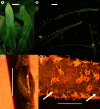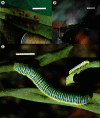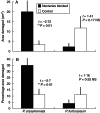Nectar secretion on fern fronds associated with lower levels of herbivore damage: field experiments with a widespread epiphyte of Mexican cloud forest remnants - PubMed (original) (raw)
Comparative Study
. 2013 Jun;111(6):1277-83.
doi: 10.1093/aob/mct063. Epub 2013 Apr 21.
Affiliations
- PMID: 23609022
- PMCID: PMC3662509
- DOI: 10.1093/aob/mct063
Comparative Study
Nectar secretion on fern fronds associated with lower levels of herbivore damage: field experiments with a widespread epiphyte of Mexican cloud forest remnants
Suzanne Koptur et al. Ann Bot. 2013 Jun.
Abstract
Background and aims: The oldest group of plants in which nectar secretions have been observed are the Polypodiopsida (ferns sensu lato). Nectaries have been reported in a dozen extant genera. The function of these nectaries has been investigated in several fern species, and in some circumstances has been demonstrated to have an antiherbivore role, attracting and maintaining biotic defence (ants and/or other predatory arthropods). This study documents foliar nectaries in Pleopeltis crassinervata, a widespread Central American epiphyte growing on a variety of trees in cloud forest areas of Veracruz, Mexico. This is a new record for this genus and species.
Methods: As previous experimental work on epiphytic species of Polypodium has demonstrated a protective role of ants for developing fronds, we conducted similar experiments (using nylon nail polish to cover nectaries rather than excluding ants with bands of sticky resin as in earlier work). The fronds of Pl. crassinervata developed over 6 weeks, at which time damage was assessed. The experiment was simultaneously conducted on a sympatric species lacking nectaries, Polypodium furfuraceum. Herbivore placement experiments were conducted with large and small caterpillars on both of these ferns.
Key results: Fronds with nectaries covered suffered greater damage from herbivores over the course of their development, compared with fronds that had uncovered nectaries functioning normally. The parallel experiment on Po. furfuraceum showed no difference between manipulated and control fronds. Six species of ants (Brachymyrmex minutus, Crematogaster formosa, Paratrechina longicornis, Solenopsis geminata, S. picea and Wasmannia auropunctata) were observed visiting nectaries of Pl. crassinervata; most were effective in removing herbivore larvae placed on the fronds.
Conclusions: The long evolutionary history of ferns may explain why some previous studies of fern nectaries have shown little or no benefit to ferns from nectary visitors, as any coevolved herbivores are those resistant to ant defence. The results suggest that ants protect Pl. crassinervata fronds against herbivory. The presence of nectaries, and the relationship with ants, may contribute to this fern's widespread occurrence and persistence in the face of disturbance, though many other factors also play a role. Ant defence may be more likely to benefit a widespread species of disturbed habitats that encounters a wide range of non-adapted herbivores.
Keywords: Extrafloral nectar; Formicidae; Mexico; Pleopeltis crassinervata; Polypodium furfuraceum; ant protection; antiherbivore defence; cloud forest; epiphyte; extrasoral nectar; ferns; field experiment; herbivory; nectaries; pteridophytes.
Figures
Fig. 1.
(A) Epiphytic ferns growing on tree trunks: Pleopeltis crassinervata; (B) Polypodium furfuraceum; (C) nectar droplet on nectary on adaxial surface of frond lamina base (×24), Pleopeltis crassinervata; (D) abaxial surface of lamina lobe of Polypodium furfuraceum with hydathodes (×40), two of which are indicated by arrows. Scale bars: (A, B) = 1 cm; (C, D) = 1 mm.
Fig. 2.
Insects associated with the ferns in this study: (A) sawfly larva, (B) orthopteran nymph, and (C) caterpillars (of common green-eyed white butterfly, Leptophobia aripa, Pieridae) used in placement experiments. The main image in (C) shows a large, 5th instar caterpillar, whilst the inset shows a small, 2nd instar one. Scale bars = 1 cm.
Fig. 3.
Duration of time on plants for Leptophobia aripa caterpillars placed on fronds of both fern species (mean+s.e., n = 14; 10-min maximum). Small = second instar caterpillars; large = fifth instar caterpillars. Results of univariate ANOVA: overall _F_3,1 = 10·15, P <.0001; fern type _F_1,13 = 30·4, P<0·0001; caterpillar size _F_1,13 = 0·002, P = 0·96; fern type × caterpillar size _F_1,55 = 0·062, P = 0·805.
Fig. 4.
Fates of caterpillars in placement experiments on both fern species (caterpillar sizes combined). Pearson χ2 = 20·96, P<0·0001 (n = 28); both ant-encounter categories were combined to meet the requirements for expected counts for this test.
Fig. 5.
Damage to developing fronds of both fern species (means+s.e.). (A) Pleopeltis crassinervata fronds with nectaries blocked sustained much greater damage than control fronds; Polypodium furfuraceum fronds showed no significant difference between experimental and control. (B) Percentage damage, which shows the same pattern.
Similar articles
- Ant protection of the nectaried fern Polypodium plebeium in central Mexico.
Koptur S, Rico-Gray V, Palacios-Rios M. Koptur S, et al. Am J Bot. 1998 May;85(5):736. Am J Bot. 1998. PMID: 21684956 - Nectaries in ferns: their taxonomic distribution, structure, function, and sugar composition.
Mehltreter K, Tenhaken R, Jansen S. Mehltreter K, et al. Am J Bot. 2022 Jan;109(1):46-57. doi: 10.1002/ajb2.1781. Epub 2022 Jan 7. Am J Bot. 2022. PMID: 34643269 - Extrafloral nectar secretion from wounds of Solanum dulcamara.
Lortzing T, Calf OW, Böhlke M, Schwachtje J, Kopka J, Geuß D, Kosanke S, van Dam NM, Steppuhn A. Lortzing T, et al. Nat Plants. 2016 Apr 25;2(5):16056. doi: 10.1038/nplants.2016.56. Nat Plants. 2016. PMID: 27243650 - Review: Nectar biology: From molecules to ecosystems.
Roy R, Schmitt AJ, Thomas JB, Carter CJ. Roy R, et al. Plant Sci. 2017 Sep;262:148-164. doi: 10.1016/j.plantsci.2017.04.012. Epub 2017 May 4. Plant Sci. 2017. PMID: 28716410 Review. - Nightshade Wound Secretion: The World's Simplest Extrafloral Nectar?
Heil M. Heil M. Trends Plant Sci. 2016 Aug;21(8):637-638. doi: 10.1016/j.tplants.2016.06.004. Trends Plant Sci. 2016. PMID: 27375224 Review.
Cited by
- Secondary Metabolites in Nectar-Mediated Plant-Pollinator Relationships.
Barberis M, Calabrese D, Galloni M, Nepi M. Barberis M, et al. Plants (Basel). 2023 Jan 25;12(3):550. doi: 10.3390/plants12030550. Plants (Basel). 2023. PMID: 36771634 Free PMC article. Review. - The Influence of Host Plant Extrafloral Nectaries on Multitrophic Interactions: An Experimental Investigation.
Koptur S, Jones IM, Peña JE. Koptur S, et al. PLoS One. 2015 Sep 22;10(9):e0138157. doi: 10.1371/journal.pone.0138157. eCollection 2015. PLoS One. 2015. PMID: 26394401 Free PMC article. - Nectar in Plant-Insect Mutualistic Relationships: From Food Reward to Partner Manipulation.
Nepi M, Grasso DA, Mancuso S. Nepi M, et al. Front Plant Sci. 2018 Jul 19;9:1063. doi: 10.3389/fpls.2018.01063. eCollection 2018. Front Plant Sci. 2018. PMID: 30073014 Free PMC article. Review. - Seedling-herbivore interactions: insights into plant defence and regeneration patterns.
Barton KE, Hanley ME. Barton KE, et al. Ann Bot. 2013 Aug;112(4):643-50. doi: 10.1093/aob/mct139. Ann Bot. 2013. PMID: 23925939 Free PMC article. Review. - Convergent evolution of fern nectaries facilitated independent recruitment of ant-bodyguards from flowering plants.
Suissa JS, Li FW, Moreau CS. Suissa JS, et al. Nat Commun. 2024 May 24;15(1):4392. doi: 10.1038/s41467-024-48646-x. Nat Commun. 2024. PMID: 38789437 Free PMC article.
References
- Apple J, Feener DJ. Ant visitation of extrafloral nectaries of Passiflora: the effects of nectary attributes and ant behavior on patterns in facultative ant–plant mutualisms. Oecologia. 2001;127:409–416. - PubMed
- Arens NC, Smith AR. Cyathea planadae, a remarkable new creeping tree fern from Colombia, South America. American Fern Journal. 1998;88:49–59.
- Bonnier G. Les nectaires. Étude critique, anatomique, et physiologique. Annals des Sciences Naturelles, Botanique, serie 6. 1879;8:5–212.
- Cooper-Driver GA. Defense strategies in bracken, Pteridium aquilinum L. Kuhn. Annals of the Missouri Botanical Garden. 1990;77:281–286.
- Cuautle M, Rico-Gray V. The effect of wasps and ants on the reproductive success of the extrafloral nectaried plant Turnera ulmifolia (Turneraceae) Functional Ecology. 2003;17:417–423.
Publication types
MeSH terms
Substances
LinkOut - more resources
Full Text Sources
Other Literature Sources
Research Materials




